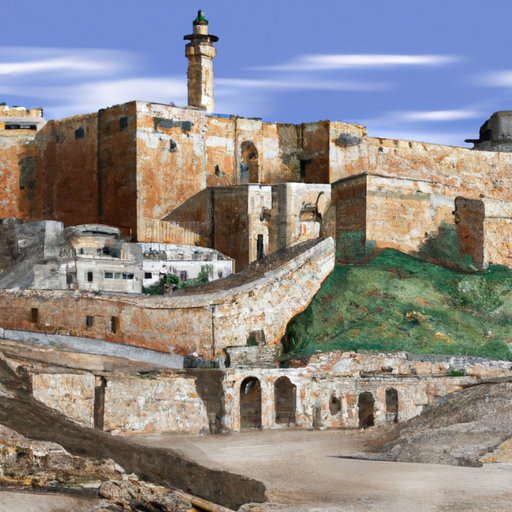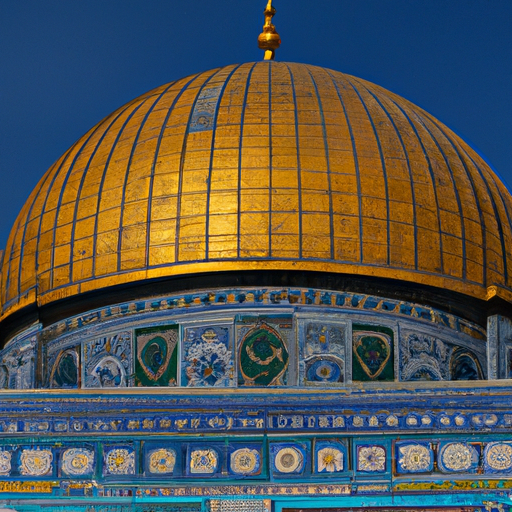This blog post explores the architectural wonders of Jerusalem, the city that is not only rich in historical and cultural significance but also a home to some of the most stunning architectural marvels in the world. From ancient structures to modern designs, Jerusalem's architecture tells a story of its diverse and complex history.
Embracing the Past: The Ancient Structures of Jerusalem
Jerusalem, a city teeming with rich history and cultural significance, is home to some of the world's most captivating architectural marvels. Its ancient structures stand as testaments to the city's enduring past and draw countless visitors from around the globe. The Old City, a UNESCO World Heritage site, is a treasure trove of architectural wonders, with its maze-like alleyways leading to breathtaking structures such as the Western Wall, the Dome of the Rock, and the Church of the Holy Sepulchre.
Walking through the narrow streets of Jerusalem's Old City is like stepping back in time. The ancient structures, built centuries ago, exude an air of mystery and intrigue. The intricate stonework, arches, and domes showcase the architectural prowess of the civilizations that once inhabited this land. From the Roman, Byzantine, and Islamic periods to the Crusader era, each era has left its mark on the city's architectural landscape.
One cannot help but marvel at the grandeur of the Western Wall, the holiest site in Judaism. This ancient structure, constructed with massive stones, has withstood the test of time and serves as a symbol of resilience and devotion. The Dome of the Rock, with its golden dome and stunning mosaics, is a masterpiece of Islamic architecture that leaves visitors in awe of its beauty and significance. And the Church of the Holy Sepulchre, believed to be the site of Jesus' crucifixion and burial, is a stunning example of Byzantine architecture, with its intricate frescoes and ornate chapels.

A panoramic view of the ancient city walls of Jerusalem, standing tall since the 16th century.
The Fusion of Old and New: How does Modern Architecture Coexist with the Ancient?
In a city as historically significant as Jerusalem, the coexistence of ancient and modern architecture is a delicate balance between preserving the past and embracing the future. This fusion is evident in the city's skyline, where towering glass skyscrapers stand alongside ancient stone structures.
- Preserving the Old:
Restoration and Conservation EffortsOne approach to maintaining the integrity of ancient architecture is through restoration and conservation efforts. Skilled craftsmen work tirelessly to preserve the original materials and techniques used in constructing these ancient structures. This ensures that the essence and authenticity of the architecture are retained, even as the city evolves around it. From meticulous stone restoration to preserving intricate mosaics, these efforts ensure that the ancient structures remain integral parts of Jerusalem's architectural landscape.
- Integrating the New:
Contemporary Designs with Contextual SensitivityContemporary architects faced with the challenge of designing in a city steeped in history must find ways to create modern structures that harmoniously coexist with the ancient surroundings. The key lies in contextual sensitivity. Architects take inspiration from the city's architectural heritage, incorporating elements such as Jerusalem stone or traditional design motifs into their modern designs. This creates a visual connection between the old and the new, allowing the modern structures to seamlessly blend into the historical fabric of the city.
- Public Spaces:
Harmonious Interaction between Old and NewPublic spaces provide an opportunity for old and new architecture to interact harmoniously. Jerusalem's modern plazas and promenades often feature elements that pay homage to the city's architectural heritage. For instance, contemporary buildings may incorporate traditional arches or use materials that mimic the surrounding ancient structures. This intentional design approach fosters a sense of continuity, creating a seamless transition between the old and the new. It allows visitors and locals to appreciate the historical significance of the city while embracing the modern developments that contribute to its growth and vibrancy.
"The beauty of the buildings speak for themselves." – The Aesthetic Appeal of Jerusalem's Architecture
The aesthetic appeal of Jerusalem's architecture is undeniable. The city is a visual feast for the eyes, with a diverse array of architectural styles that span centuries. From the intricate details of the Old City's stone facades to the sleek lines of modern skyscrapers, Jerusalem's buildings captivate with their unique charm.
One of the defining features of Jerusalem's architecture is its use of Jerusalem stone. This locally quarried limestone gives the city its distinctive golden hue and imparts a sense of timelessness to its buildings. The warm tones of the stone, especially when illuminated by the golden light of the setting sun, create a magical ambiance that enchants both residents and visitors alike.
Beyond the use of Jerusalem stone, the city's architecture reflects its rich history and cultural heritage. The Old City, with its labyrinthine streets and ancient structures, showcases a stunning blend of Middle Eastern, European, and Byzantine architectural styles. From the iconic Dome of the Rock with its intricate mosaics to the arched passageways and vaulted ceilings of the Old City's markets, each building tells a story of the civilizations that have shaped Jerusalem.
In contrast, the modern architecture of Jerusalem showcases sleek lines, innovative designs, and contemporary materials. The city's skyline is dotted with high-rise buildings that boast cutting-edge architectural feats. From the iconic Bridge of Strings that spans the entrance to the city to the soaring towers of the Mamilla neighborhood, modern Jerusalem's architecture is a testament to the city's growth and development.

A detailed shot of the intricate design and craftsmanship on the Dome of the Rock, a testament to Jerusalem's aesthetic appeal.
The Influence of Various Cultures on Jerusalem's Architecture: A Testament to Diversity?
Jerusalem's architecture is a testament to its rich history and the diverse cultures that have left their mark on the city. Over the centuries, Jerusalem has been home to numerous civilizations, each leaving their architectural imprint. From the ancient Canaanites to the Romans, Byzantines, Arabs, Crusaders, Ottomans, and British, each culture has contributed to the unique architectural tapestry of the city.
The diverse influences on Jerusalem's architecture can be seen in the different styles, materials, and motifs used in its buildings. The Old City, in particular, showcases a fascinating mix of architectural elements, from the Islamic-inspired domes and minarets to the Romanesque arches and Gothic spires. The blending of these styles creates a harmonious fusion that is a visual representation of the city's multicultural heritage.
Moreover, the religious significance of Jerusalem has also played a significant role in shaping its architecture. The city is considered holy by three major religions – Judaism, Christianity, and Islam. As a result, Jerusalem is adorned with religious sites and sacred structures that reflect the beliefs and architectural traditions of these religions. From the Western Wall and the Church of the Holy Sepulcher to the Al-Aqsa Mosque and the Dome of the Rock, each religious site tells a story of faith, devotion, and architectural brilliance.
The influence of various cultures on Jerusalem's architecture extends beyond the religious realm. It is also evident in the city's residential and commercial buildings, public spaces, and infrastructure. The diverse architectural styles reflect the ebb and flow of history, showcasing the city's ability to absorb and integrate different cultural influences over time.
Jerusalem, with its rich architectural tapestry, is a testament to the city's resilience and adaptability. Its structures, both ancient and modern, tell a story of a city that has been at the center of world history for millennia. Each building, each stone, carries a piece of history and stands as a symbol of Jerusalem's enduring spirit. Whether you are an architecture enthusiast or a history buff, Jerusalem's architectural marvels are a sight to behold.
Please read more about how to tour in Jerusalem.